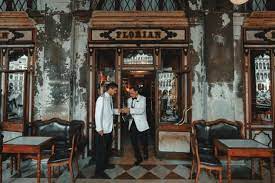How Italy came to be Europe’s coffee capital

Rome: Given how protective Italians can be over their coffee culture, you might be forgiven for thinking they invented the drink.
But that title actually goes to Ethiopia, where much of the world’s coffee is still grown today.
According to the coffee blog Home Grounds, the story goes that in 700 AD, an Abyssinian goatherder named Kaldi found his goats prancing around and acting strangely.
Seeing red berries on some nearby bushes, Kaldi surmised that they might be behind his herd’s odd behaviour.
At this point different versions of the story diverge in their telling: one says Kaldi gave the berries to a monk, who was happy to find something to help him stay awake to pray all night; another says the monk disapproved and threw the beans on the fire, where they released the delicious aroma of roasted coffee beans.
Either way, humans started drinking coffee, and they haven’t stopped since. From Ethiopia, coffee spread across the ocean to Yemen and proliferated throughout the Arabian peninsula. Here it gave rise coffeehouses or qahveh khaneh, which became hubs of social and cultural activity.
Coffee didn’t make its way to Italy until 16th century, when Venetian sailors brought it back from the Ottoman empire.
At first this black, bitter liquid was feared to be from the devil, and local priests called on Pope Clement VIII to denounce it.
But, the legend goes, the pope decided to give the drink a try before delivering his judgement; and after a few sips, he proclaimed, “This Satan’s drink is so delicious that it would be a pity to let the infidels have exclusive use of it.” He gave the drink his blessing – but not before baptising the beans, just to be safe.
Coffeehouses subsequently started popping up in Venice in around the late 17th century, and by the mid-1700s there were over 200 of them, frequented by great artists, writers and poets of the time.
But it wasn’t until the late 19th century that a series of Italian inventors started devising the innovations that led to Italy gaining its current reputation as Europe’s custodian of coffee.
As coffee became more and more popular, people started looking for ways to produce it at speed rather than having to leave each cup to brew for several minutes, and the idea of forcing steam through coffee grounds at pressure in order to make coffee quickly began to take hold.
An old-fashioned Italian espresso machine. Photo by Gabriella Clare Marino on Unsplash The first effort at something approaching an espresso (literally, ‘pressed out’) machine was presented by Angelo Moriondo at the Turin General Exposition in 1884, where it won a bronze medal – but the device was somewhat impractical in its design, and was never produced commercially.
A while later, in 1901, Milanese inventor Luigi Bezzerra developed and patented a smaller and more efficient version of the machine, making it commercially viable, though it still had some faults.
By 1906, Bezzerra and fellow inventor Desiderio Pavoni had more or less perfected their version of the instrument, and the first steam-based espresso machine went on the market.
This device was ultimately replaced by Achille Gaggia’s 1938 invention, which dispensed with the steam (which could give the coffee a burnt flavour) and made espresso by forcing hot water through the coffee grounds at very high pressure, producing a highly concentrated drink very similar to what we think of as espresso today.
In between, one Alfonso Bialetti came out with his stovetop Moka caffettiera in 1933, which allowed ordinary Italians to make something not unlike espresso coffee in the comfort of their own homes.
With these inventions, Italy developed a reputation for being Europe’s, if not the world’s, coffee capital – a recognition it guards fiercely today.
The question of who ‘owns’ Italy’s coffee culture was raised earlier this year, when it transpired that the Consortium for the Protection of Traditional Italian Espresso Coffee in Treviso and the Region of Campania had separately sought UNESCO recognition for the espresso coffee tradition; the consortium representing all of Italy and Campania representing Naples, which is particularly proud of its coffee culture.
One academic who worked on Campania’s bid decried the Treviso consortium’s application as “an act of war by the north against the south”, the Wall Street Journal reported at the time, while the consortium’s founder Giorgio Caballini described Naples’ attempt to assert ownership over Italian espresso as “unacceptable”.
In the end, neither won: Italy’s UNESCO committee told the two groups it was disallowing both their candidacies, and to apply again as a united front next year. Hopefully, they can resolve their differences – perhaps over an espresso or two.





